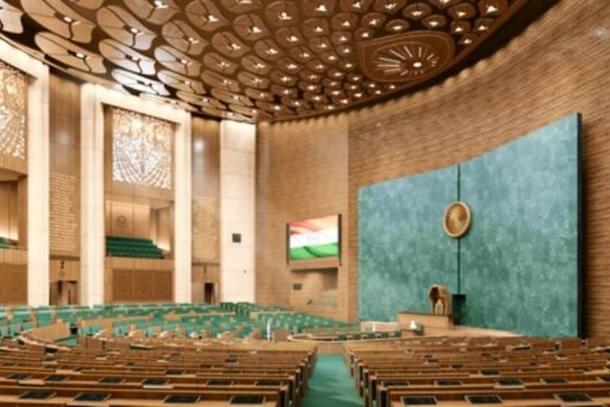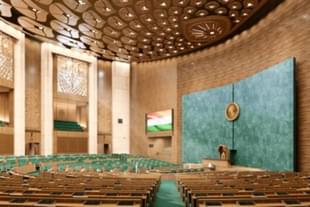Politics
Go Small, Win Big: How Redrawing State Lines Makes Delimitation Easier
Gautam Desiraju and Deekhit Bhattacharya
Aug 10, 2024, 09:19 PM | Updated 09:22 PM IST
Save & read from anywhere!
Bookmark stories for easy access on any device or the Swarajya app.


The Constitution of India describes the country as a union of states, and the Seventh Schedule lays down a clear division of powers and responsibilities. This, in turn, charts out how a state works and what it ought to do.
However, Article 2, which is supposed to define what a state is, remains vague—deliberately or otherwise. Article 2 merely says that “Parliament may by law admit into the Union, or establish, new States [sic] on such terms and conditions as it thinks fit.”
To repudiate any hint of sovereignty ascribed (erroneously) to any of the constituent states of Bharat, the word “state” will be used in this article in small letters to describe them. This is to clearly distinguish them from sovereign entities wherein the capitalised appellation “State” is appropriate, as in say “Indian State”, to connote the sovereign democratic republic of India, that is Bharat.
All politics boils down to a combination of identity and economics.
Identity is what one is, while economics is a part of what one does. Felicity in understanding what one does accompanied by an inability to clearly define what one is, is a characteristic of a complex system.
Such systems are widely recognised in science. Our country Bharat is a textbook example of a complex system. A problem with our constitution is that it attempts to define what a state is through what it does. This is one of several serious problems in our constitution.
Clause 14, Chapter I, Part I of the States Reorganisation Committee Report of 1955 summarises the position pithily: “The existing structure of the States [sic] of the Indian Union is partly the result of accident and the circumstances attending the growth of the British power in India and partly a by-product of the historic process of the integration of former Indian States. The division of India during the British period into British provinces and Indian States was itself fortuitous and had no basis in Indian history.”
Language becoming the primary determinant of identity is a recent phenomenon in our civilisational history. It is fully artificial.
The partition of Bengal in 1905, and its subsequent reunification in 1911 was also accompanied by the creation of the linguistic provinces of Orissa and Assam. The separation of a Telugu speaking state from the erstwhile Madras Presidency in 1953, and the appearance of Kannada, Marathi and Gujarati speaking states thereafter, established the pattern. Tamil Nadu defaulted into becoming a linguistic state because of the formation of Andhra Pradesh.
The setting up of these linguistic states, intentional or otherwise, by Jawaharlal Nehru was arguably the single biggest political blunder made in post-independence India. Today, this fake linguistic identity has morphed into calls for ‘secession’ in a North-South divide, aided and abetted by the Congress party and some regional outfits.
Ironically, the first linguistic state formed in independent India, namely Andhra Pradesh, was divided in 2014 into two Telugu speaking states (Andhra Pradesh and Telangana) demonstrating the hollowness of the linguistic state idea in a modern forward looking country.
Historically, Telugu was always the court language and the language of the higher classes in most parts of southern India for at least 1,000 years right down till 1947. It enjoyed a status equal to that of Sanskrit in the fine arts.
Inscriptions in Telugu are found in the recently excavated Gyanvapi Vishwanath Mandir and seem to have been inserted there by pilgrims from what would today be northern Karnataka.
Historically speaking, the Telugu language has always been a unifier and not a divider. Language is, in the end, a social convenience and not an identity marker.
The consequences of linguistic states are deleterious in many ways.
1. Large linguistic states have had lopsided developmental trajectories. Karnataka, Maharashtra, Tamil Nadu and West Bengal, each with a huge metro city, are grossly overdependent on the same. Concerns of those who live beyond the shadows of these megacities are eclipsed. This greatly fuels intrastate inequalities.
2. Cultural diversities are smothered by the singular blanket of linguistic uniformity and regions with markedly different dialects (Garhwal and Kumaon; Jammu and Kashmir; Rayalaseema and Andhra) are disturbingly homogenised. In turn, this leads to divisive politics marked by clientelism, casteism, and secessionist subnationalism.
3. The singular stress on language instead of an accommodative multivariate understanding of identity, makes interstate divisions stark instead of being on a continuum, making it easier to divide Indians rather than uniting them.
At this time, an independent issue is to have a delimitation of parliamentary and assembly constituencies to make our parliamentary democracy more fair and representative. This has been alluded to several times in the recent past by the central government. The construction of a new parliament building with the capability of seating 888 members in the lower house is a hint in this direction.
This article now details how these two independent issues, namely delimitation of Lok Sabha constituencies and reorganisation of states, may be profitably linked for the furtherance of our democracy.
At the outset, the frozen number of 543 seats in the Lok Sabha is violative of Article 14, i.e. equality before law and equal protection of the law.
This number is not sacrosanct, and has been arrived at by successive delimitations until 1976, which ensured that each MP in the Lok Sabha represents roughly an equal number of citizens. Reality is quite far from this ideal scenario; some Indians thus get to have greater say in the running of this country, flying in the face of equality of citizens.
As per the Election Commission of India, the five largest parliamentary constituencies of the country in terms of number of electors constitute 1,16,51,249 electors taken together, while the smallest five together have 7,56,820 electors. The total electorate size in the largest five is thus 15.4 times of that in the smallest five. We may term this as a “skew ratio”. These skewed numbers show that the electoral significance of a vote can differ significantly from one constituency to another.
Additionally, if one takes the voting population of India as 97 crore, then there are on average 17 lakh voters represented by each Lok Sabha member currently. This number is way too large and it means that an individual voter has, for all practical purposes, lost any direct contact with the person he or she has elected to the Lok Sabha.
Based on the number of seats in the new parliament building, one might assume that there will be 888 Lok Sabha members in a Lower House constituted after a nationwide delimitation exercise.
In such an event, one arrives at an average figure of 10 lakh voters per constituency, which appears to be more reasonable. However, if this exercise is done proportionately (1 constituency today becomes 1.69 constituencies after delimitation), the skew ratio still stays high, meaning that the value of an individual vote will still remain widely different in different parts of the country.
Alternatively, if the exercise is carried out population wise, there will be a marked decrease in the representation of the southern states.
Both methods are therefore unsatisfactory.
Any increase in the number of constituencies must therefore be accompanied by a complete redrawing of limits so that there are just around 10 lakh voters in each and every new constituency in the country with the skew ratio approaching 1.00. However, even this is not enough, given the present structuring of the states.
This is so because the connection between any future parliamentary delimitation exercise and the manner and way in which states of the Indian Union have been defined by Parliament would still remain tenuous.
The present 28 states and eight Union Territories (UT) are shockingly different in size. These differences are partly on account of former historical events, and partly on account of a reluctance by some, mostly in the larger (linguistic) states, to consider division of their states into smaller, more governable units, blocking such moves and using language as a convenient excuse.
The recent gymnastics in Karnataka with respect to quotas for Kannada speaking employees in private industry is a case in point. A comprehensive reorganisation of states is, however, almost mandatory today and unless this exercise is done ab initio it will lack objectivity and rationality. It cannot be done incrementally.
Such reorganisation should smoothly dovetail into the parliamentary delimitation exercise, so that each newly constituted state has more or less equal representation in the new parliament.
The question of larger states dominating the political discourse would be then relegated to history.
Uttar Pradesh might be accused today by Tamil Nadu of dominating it in certain ways, but it is hardly likely that a Kongu Nadu would similarly accuse an equally populated Awadh. No new state would be affected by so-called North-South demographic differences, because all states would have nearly the same population, and thus a roughly equal say in the trajectory of the country.
In this way, two independent phenomena, namely delimitation and states reorganisation, would be brought together synergistically.
Simultaneously, the unhealthy concentration of resources, political power, and opportunities in singular megacities can be checked, resulting in a more equal distribution of prosperity.
Likewise, economic policymaking becoming more decentralised can enable regions to specialise in goods and services as per their competencies, unimpeded from distant state capitals which remain less than responsive to such demands.
Gautam R. Desiraju is in UPES, Dehradun and IISc, Bengaluru. Deekhit Bhattacharya is a lawyer practising in Delhi. Views expressed here are those of the authors in their personal capacities.
Gautam R. Desiraju (IISc Bangalore and UPES Dehradun) and Deekhit Bhattacharya (Luthra and Luthra Law Offices India) Views are personal to the authors.





